Global Financial Crisis Impact Analysis
VerifiedAdded on 2020/06/05
|9
|2587
|27
AI Summary
This assignment delves into the profound impact of the Global Financial Crisis (GFC) on worldwide economies. It highlights key consequences such as diminished economic growth, low GDP rates, decreased exports and income flow, and reduced investments. The analysis further explores the various challenges arising from these factors, including unemployment and declining stock prices. The assignment also examines the measures implemented by the International Monetary Fund (IMF) to mitigate the effects of the GFC.
Contribute Materials
Your contribution can guide someone’s learning journey. Share your
documents today.
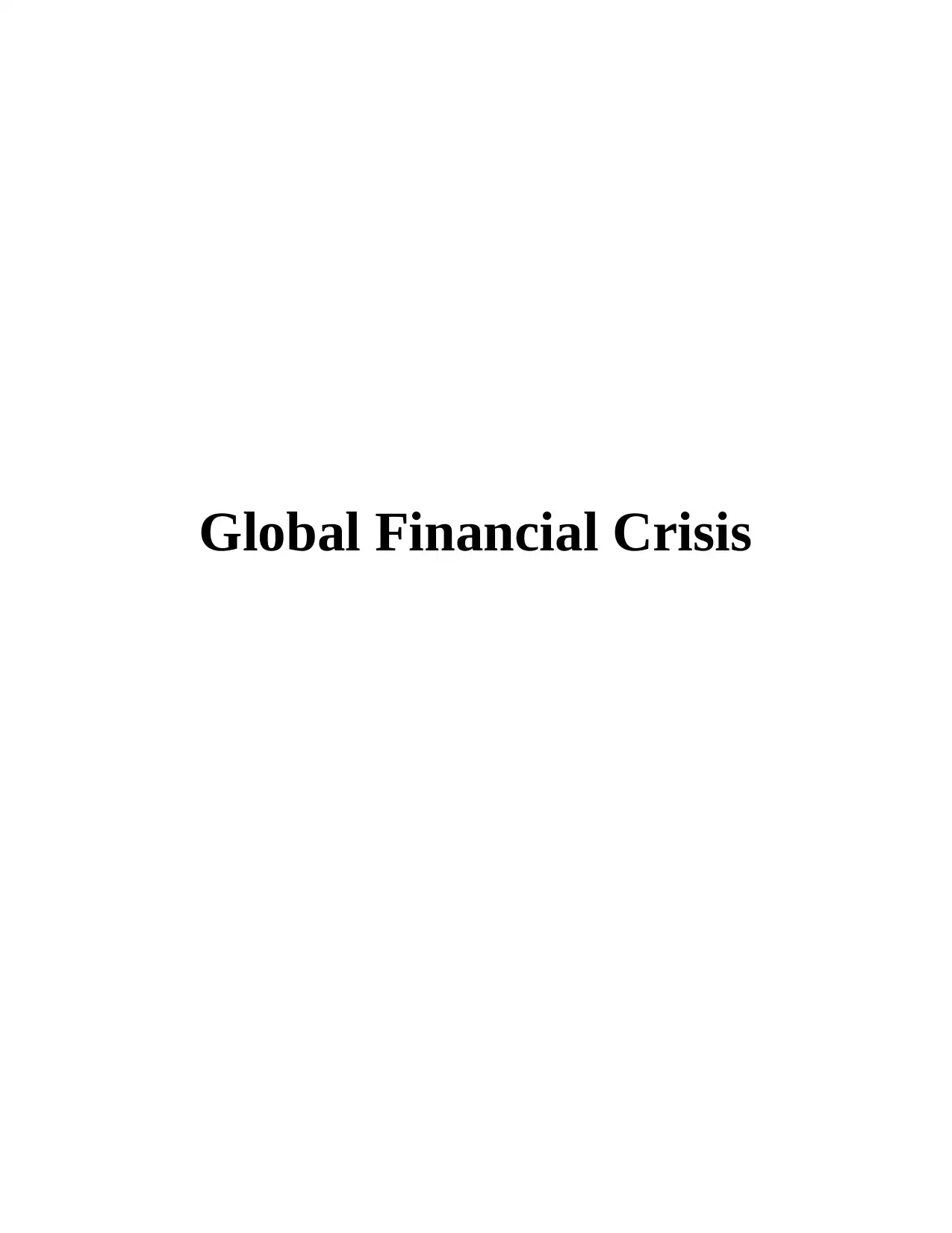
Global Financial Crisis
Secure Best Marks with AI Grader
Need help grading? Try our AI Grader for instant feedback on your assignments.
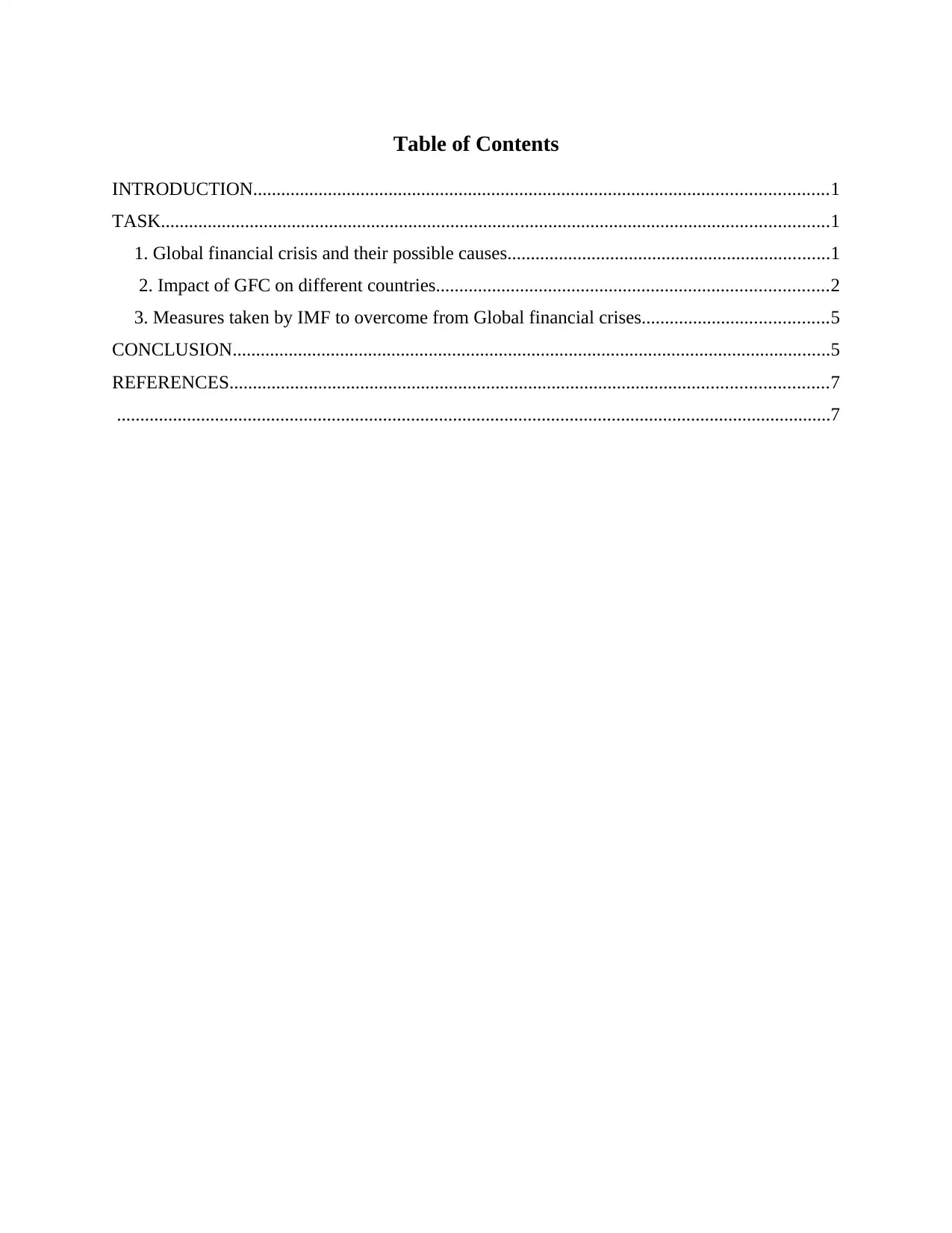
Table of Contents
INTRODUCTION...........................................................................................................................1
TASK...............................................................................................................................................1
1. Global financial crisis and their possible causes.....................................................................1
2. Impact of GFC on different countries....................................................................................2
3. Measures taken by IMF to overcome from Global financial crises........................................5
CONCLUSION................................................................................................................................5
REFERENCES................................................................................................................................7
.........................................................................................................................................................7
INTRODUCTION...........................................................................................................................1
TASK...............................................................................................................................................1
1. Global financial crisis and their possible causes.....................................................................1
2. Impact of GFC on different countries....................................................................................2
3. Measures taken by IMF to overcome from Global financial crises........................................5
CONCLUSION................................................................................................................................5
REFERENCES................................................................................................................................7
.........................................................................................................................................................7
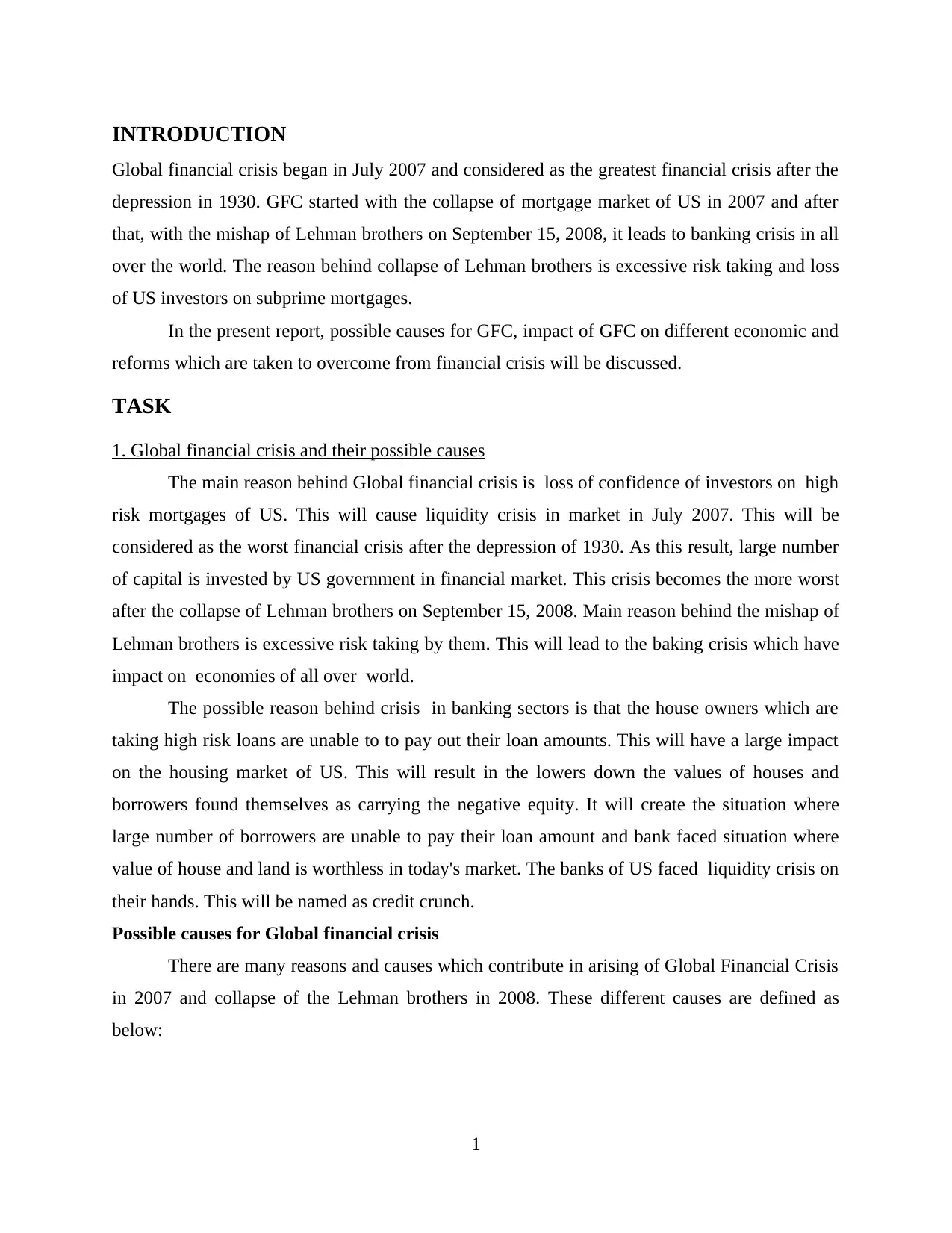
INTRODUCTION
Global financial crisis began in July 2007 and considered as the greatest financial crisis after the
depression in 1930. GFC started with the collapse of mortgage market of US in 2007 and after
that, with the mishap of Lehman brothers on September 15, 2008, it leads to banking crisis in all
over the world. The reason behind collapse of Lehman brothers is excessive risk taking and loss
of US investors on subprime mortgages.
In the present report, possible causes for GFC, impact of GFC on different economic and
reforms which are taken to overcome from financial crisis will be discussed.
TASK
1. Global financial crisis and their possible causes
The main reason behind Global financial crisis is loss of confidence of investors on high
risk mortgages of US. This will cause liquidity crisis in market in July 2007. This will be
considered as the worst financial crisis after the depression of 1930. As this result, large number
of capital is invested by US government in financial market. This crisis becomes the more worst
after the collapse of Lehman brothers on September 15, 2008. Main reason behind the mishap of
Lehman brothers is excessive risk taking by them. This will lead to the baking crisis which have
impact on economies of all over world.
The possible reason behind crisis in banking sectors is that the house owners which are
taking high risk loans are unable to to pay out their loan amounts. This will have a large impact
on the housing market of US. This will result in the lowers down the values of houses and
borrowers found themselves as carrying the negative equity. It will create the situation where
large number of borrowers are unable to pay their loan amount and bank faced situation where
value of house and land is worthless in today's market. The banks of US faced liquidity crisis on
their hands. This will be named as credit crunch.
Possible causes for Global financial crisis
There are many reasons and causes which contribute in arising of Global Financial Crisis
in 2007 and collapse of the Lehman brothers in 2008. These different causes are defined as
below:
1
Global financial crisis began in July 2007 and considered as the greatest financial crisis after the
depression in 1930. GFC started with the collapse of mortgage market of US in 2007 and after
that, with the mishap of Lehman brothers on September 15, 2008, it leads to banking crisis in all
over the world. The reason behind collapse of Lehman brothers is excessive risk taking and loss
of US investors on subprime mortgages.
In the present report, possible causes for GFC, impact of GFC on different economic and
reforms which are taken to overcome from financial crisis will be discussed.
TASK
1. Global financial crisis and their possible causes
The main reason behind Global financial crisis is loss of confidence of investors on high
risk mortgages of US. This will cause liquidity crisis in market in July 2007. This will be
considered as the worst financial crisis after the depression of 1930. As this result, large number
of capital is invested by US government in financial market. This crisis becomes the more worst
after the collapse of Lehman brothers on September 15, 2008. Main reason behind the mishap of
Lehman brothers is excessive risk taking by them. This will lead to the baking crisis which have
impact on economies of all over world.
The possible reason behind crisis in banking sectors is that the house owners which are
taking high risk loans are unable to to pay out their loan amounts. This will have a large impact
on the housing market of US. This will result in the lowers down the values of houses and
borrowers found themselves as carrying the negative equity. It will create the situation where
large number of borrowers are unable to pay their loan amount and bank faced situation where
value of house and land is worthless in today's market. The banks of US faced liquidity crisis on
their hands. This will be named as credit crunch.
Possible causes for Global financial crisis
There are many reasons and causes which contribute in arising of Global Financial Crisis
in 2007 and collapse of the Lehman brothers in 2008. These different causes are defined as
below:
1

Rating agencies: There is a huge contribution of rating agencies on the happening of
financial crisis. The rating agencies Standard and Poor's, Fitch and Moody's are classified
the securities as investment grade.
Securitization of loans: This will have a huge impact on the financial ability of banks
and contribute in the reason of financial crisis. Due to such option, they don't have the
opportunity to closely monitor underwriting standards.
Bad economic assumptions: The economists of US assumed that the home prices are
never declined on nationwide basis. This will create confidence among the underwriters
and investors to believe on mortgage back securities that they are risk free. This bad
assumption will become one of the causes of Global financial crisis.
Bankruptcy of Lehman brothers: There is huge contribution of the collapse of Lehman
brothers to become the GFC worst. This will results in more depression globally.
Monetary policy in between 2004 to 2006: As per the monetary policy between 2004 to
2006, the interest rates are very low on homes which causes housing bubble. Inefficiency
of borrowers regarding paying of their loans create the situation for banks of liquidity
crises and the value of homes and lands becomes worthless.
The failure of Indy Mac Bank: The failure of Indy Mac bank during crisis is also one
of greatest factors which makes situation worst. It is the first major depository
institution which is considered as a commercial bank in which the investors have more
than $32 billion investment. The depositors and creditors bear losses irrespective of
insurance limit.
Broken international monetary system: This is also one of reasons behind Global
financial crisis which is underappreciated. The monetary system of US is broken because
of imbalance between trading system of developing and developed countries.
2. Impact of GFC on different countries
There is huge impact Global Financial Crisis on the economies of different countries. All
the nations whether underdeveloped, developing or developed have to face the consequences of
such financial crisis. This will affect the trade between the different countries, government
policies, investors, banking institutions, big organisations etc. It will lowers down the economic
growth rate of every nations but the major loss has to be faced by all developed nations. As they
2
financial crisis. The rating agencies Standard and Poor's, Fitch and Moody's are classified
the securities as investment grade.
Securitization of loans: This will have a huge impact on the financial ability of banks
and contribute in the reason of financial crisis. Due to such option, they don't have the
opportunity to closely monitor underwriting standards.
Bad economic assumptions: The economists of US assumed that the home prices are
never declined on nationwide basis. This will create confidence among the underwriters
and investors to believe on mortgage back securities that they are risk free. This bad
assumption will become one of the causes of Global financial crisis.
Bankruptcy of Lehman brothers: There is huge contribution of the collapse of Lehman
brothers to become the GFC worst. This will results in more depression globally.
Monetary policy in between 2004 to 2006: As per the monetary policy between 2004 to
2006, the interest rates are very low on homes which causes housing bubble. Inefficiency
of borrowers regarding paying of their loans create the situation for banks of liquidity
crises and the value of homes and lands becomes worthless.
The failure of Indy Mac Bank: The failure of Indy Mac bank during crisis is also one
of greatest factors which makes situation worst. It is the first major depository
institution which is considered as a commercial bank in which the investors have more
than $32 billion investment. The depositors and creditors bear losses irrespective of
insurance limit.
Broken international monetary system: This is also one of reasons behind Global
financial crisis which is underappreciated. The monetary system of US is broken because
of imbalance between trading system of developing and developed countries.
2. Impact of GFC on different countries
There is huge impact Global Financial Crisis on the economies of different countries. All
the nations whether underdeveloped, developing or developed have to face the consequences of
such financial crisis. This will affect the trade between the different countries, government
policies, investors, banking institutions, big organisations etc. It will lowers down the economic
growth rate of every nations but the major loss has to be faced by all developed nations. As they
2
Secure Best Marks with AI Grader
Need help grading? Try our AI Grader for instant feedback on your assignments.
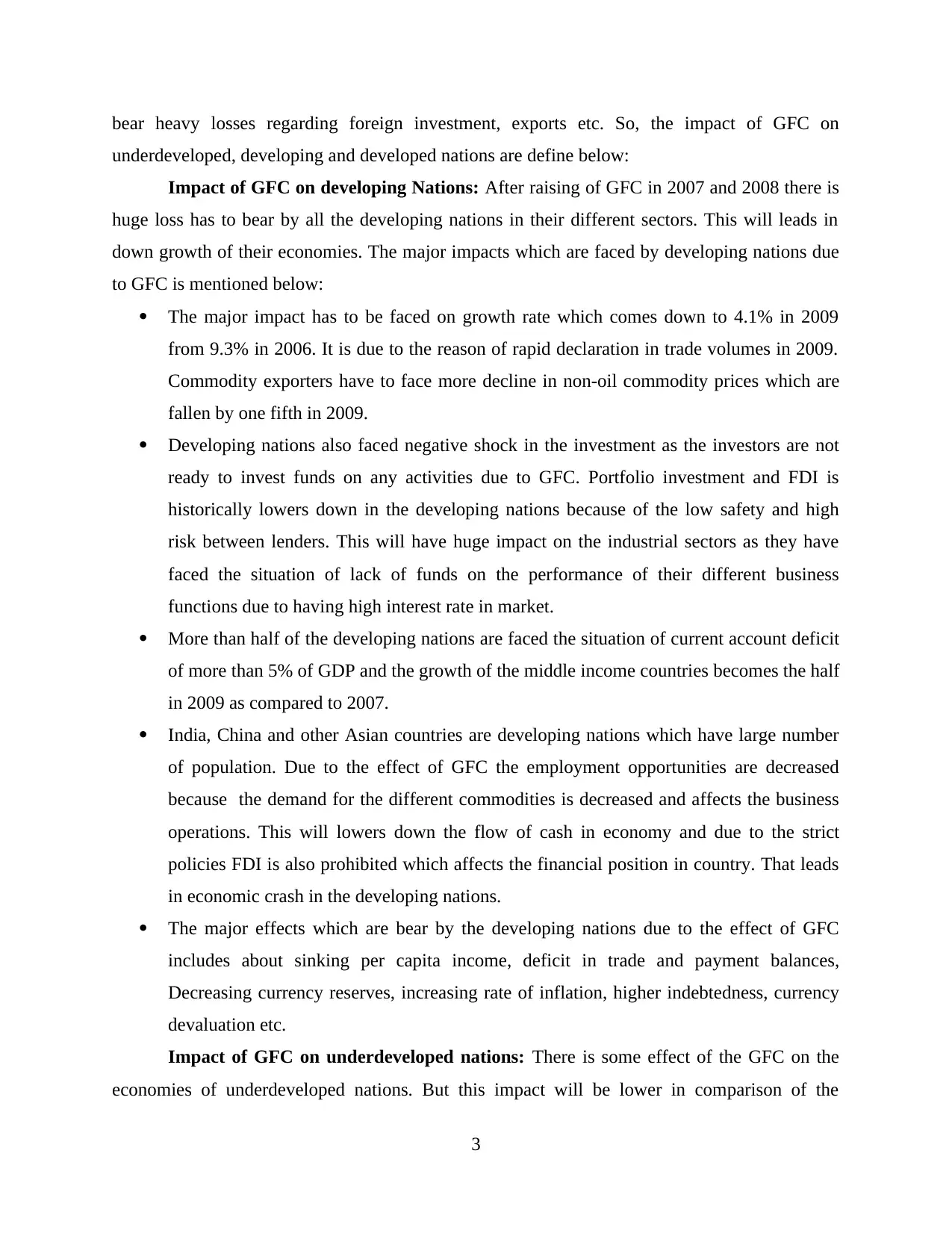
bear heavy losses regarding foreign investment, exports etc. So, the impact of GFC on
underdeveloped, developing and developed nations are define below:
Impact of GFC on developing Nations: After raising of GFC in 2007 and 2008 there is
huge loss has to bear by all the developing nations in their different sectors. This will leads in
down growth of their economies. The major impacts which are faced by developing nations due
to GFC is mentioned below:
The major impact has to be faced on growth rate which comes down to 4.1% in 2009
from 9.3% in 2006. It is due to the reason of rapid declaration in trade volumes in 2009.
Commodity exporters have to face more decline in non-oil commodity prices which are
fallen by one fifth in 2009.
Developing nations also faced negative shock in the investment as the investors are not
ready to invest funds on any activities due to GFC. Portfolio investment and FDI is
historically lowers down in the developing nations because of the low safety and high
risk between lenders. This will have huge impact on the industrial sectors as they have
faced the situation of lack of funds on the performance of their different business
functions due to having high interest rate in market.
More than half of the developing nations are faced the situation of current account deficit
of more than 5% of GDP and the growth of the middle income countries becomes the half
in 2009 as compared to 2007.
India, China and other Asian countries are developing nations which have large number
of population. Due to the effect of GFC the employment opportunities are decreased
because the demand for the different commodities is decreased and affects the business
operations. This will lowers down the flow of cash in economy and due to the strict
policies FDI is also prohibited which affects the financial position in country. That leads
in economic crash in the developing nations.
The major effects which are bear by the developing nations due to the effect of GFC
includes about sinking per capita income, deficit in trade and payment balances,
Decreasing currency reserves, increasing rate of inflation, higher indebtedness, currency
devaluation etc.
Impact of GFC on underdeveloped nations: There is some effect of the GFC on the
economies of underdeveloped nations. But this impact will be lower in comparison of the
3
underdeveloped, developing and developed nations are define below:
Impact of GFC on developing Nations: After raising of GFC in 2007 and 2008 there is
huge loss has to bear by all the developing nations in their different sectors. This will leads in
down growth of their economies. The major impacts which are faced by developing nations due
to GFC is mentioned below:
The major impact has to be faced on growth rate which comes down to 4.1% in 2009
from 9.3% in 2006. It is due to the reason of rapid declaration in trade volumes in 2009.
Commodity exporters have to face more decline in non-oil commodity prices which are
fallen by one fifth in 2009.
Developing nations also faced negative shock in the investment as the investors are not
ready to invest funds on any activities due to GFC. Portfolio investment and FDI is
historically lowers down in the developing nations because of the low safety and high
risk between lenders. This will have huge impact on the industrial sectors as they have
faced the situation of lack of funds on the performance of their different business
functions due to having high interest rate in market.
More than half of the developing nations are faced the situation of current account deficit
of more than 5% of GDP and the growth of the middle income countries becomes the half
in 2009 as compared to 2007.
India, China and other Asian countries are developing nations which have large number
of population. Due to the effect of GFC the employment opportunities are decreased
because the demand for the different commodities is decreased and affects the business
operations. This will lowers down the flow of cash in economy and due to the strict
policies FDI is also prohibited which affects the financial position in country. That leads
in economic crash in the developing nations.
The major effects which are bear by the developing nations due to the effect of GFC
includes about sinking per capita income, deficit in trade and payment balances,
Decreasing currency reserves, increasing rate of inflation, higher indebtedness, currency
devaluation etc.
Impact of GFC on underdeveloped nations: There is some effect of the GFC on the
economies of underdeveloped nations. But this impact will be lower in comparison of the
3
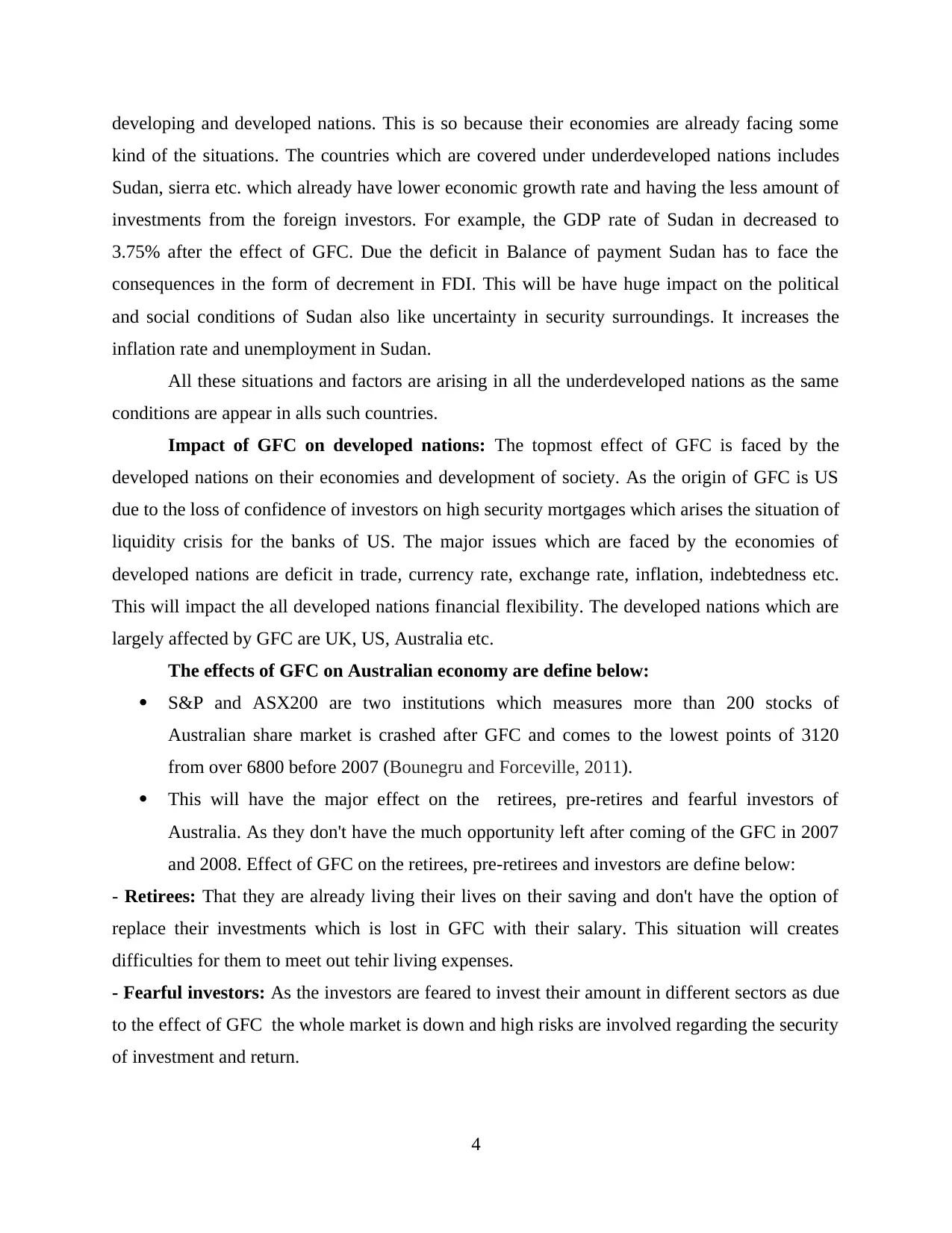
developing and developed nations. This is so because their economies are already facing some
kind of the situations. The countries which are covered under underdeveloped nations includes
Sudan, sierra etc. which already have lower economic growth rate and having the less amount of
investments from the foreign investors. For example, the GDP rate of Sudan in decreased to
3.75% after the effect of GFC. Due the deficit in Balance of payment Sudan has to face the
consequences in the form of decrement in FDI. This will be have huge impact on the political
and social conditions of Sudan also like uncertainty in security surroundings. It increases the
inflation rate and unemployment in Sudan.
All these situations and factors are arising in all the underdeveloped nations as the same
conditions are appear in alls such countries.
Impact of GFC on developed nations: The topmost effect of GFC is faced by the
developed nations on their economies and development of society. As the origin of GFC is US
due to the loss of confidence of investors on high security mortgages which arises the situation of
liquidity crisis for the banks of US. The major issues which are faced by the economies of
developed nations are deficit in trade, currency rate, exchange rate, inflation, indebtedness etc.
This will impact the all developed nations financial flexibility. The developed nations which are
largely affected by GFC are UK, US, Australia etc.
The effects of GFC on Australian economy are define below:
S&P and ASX200 are two institutions which measures more than 200 stocks of
Australian share market is crashed after GFC and comes to the lowest points of 3120
from over 6800 before 2007 (Bounegru and Forceville, 2011).
This will have the major effect on the retirees, pre-retires and fearful investors of
Australia. As they don't have the much opportunity left after coming of the GFC in 2007
and 2008. Effect of GFC on the retirees, pre-retirees and investors are define below:
- Retirees: That they are already living their lives on their saving and don't have the option of
replace their investments which is lost in GFC with their salary. This situation will creates
difficulties for them to meet out tehir living expenses.
- Fearful investors: As the investors are feared to invest their amount in different sectors as due
to the effect of GFC the whole market is down and high risks are involved regarding the security
of investment and return.
4
kind of the situations. The countries which are covered under underdeveloped nations includes
Sudan, sierra etc. which already have lower economic growth rate and having the less amount of
investments from the foreign investors. For example, the GDP rate of Sudan in decreased to
3.75% after the effect of GFC. Due the deficit in Balance of payment Sudan has to face the
consequences in the form of decrement in FDI. This will be have huge impact on the political
and social conditions of Sudan also like uncertainty in security surroundings. It increases the
inflation rate and unemployment in Sudan.
All these situations and factors are arising in all the underdeveloped nations as the same
conditions are appear in alls such countries.
Impact of GFC on developed nations: The topmost effect of GFC is faced by the
developed nations on their economies and development of society. As the origin of GFC is US
due to the loss of confidence of investors on high security mortgages which arises the situation of
liquidity crisis for the banks of US. The major issues which are faced by the economies of
developed nations are deficit in trade, currency rate, exchange rate, inflation, indebtedness etc.
This will impact the all developed nations financial flexibility. The developed nations which are
largely affected by GFC are UK, US, Australia etc.
The effects of GFC on Australian economy are define below:
S&P and ASX200 are two institutions which measures more than 200 stocks of
Australian share market is crashed after GFC and comes to the lowest points of 3120
from over 6800 before 2007 (Bounegru and Forceville, 2011).
This will have the major effect on the retirees, pre-retires and fearful investors of
Australia. As they don't have the much opportunity left after coming of the GFC in 2007
and 2008. Effect of GFC on the retirees, pre-retirees and investors are define below:
- Retirees: That they are already living their lives on their saving and don't have the option of
replace their investments which is lost in GFC with their salary. This situation will creates
difficulties for them to meet out tehir living expenses.
- Fearful investors: As the investors are feared to invest their amount in different sectors as due
to the effect of GFC the whole market is down and high risks are involved regarding the security
of investment and return.
4
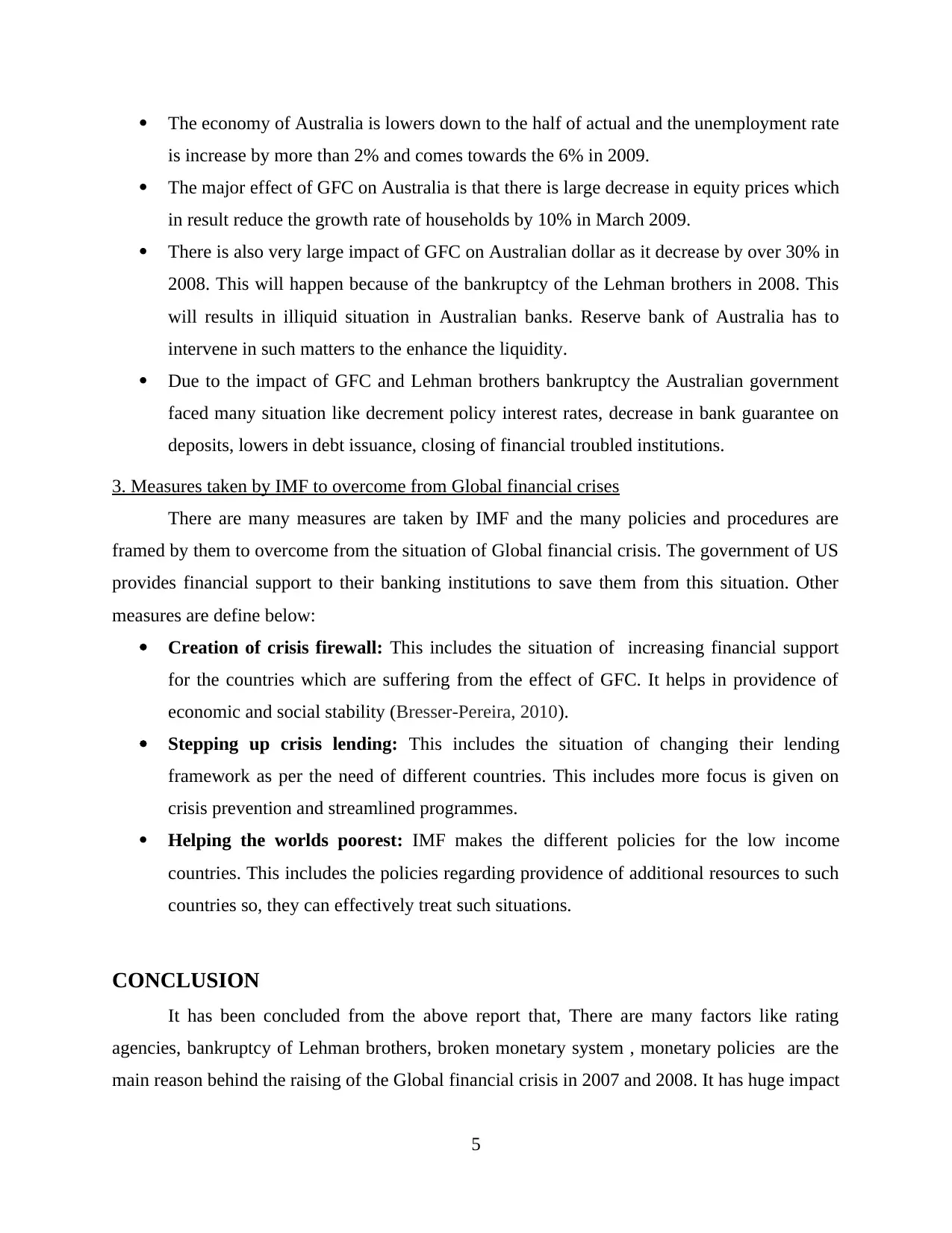
The economy of Australia is lowers down to the half of actual and the unemployment rate
is increase by more than 2% and comes towards the 6% in 2009.
The major effect of GFC on Australia is that there is large decrease in equity prices which
in result reduce the growth rate of households by 10% in March 2009.
There is also very large impact of GFC on Australian dollar as it decrease by over 30% in
2008. This will happen because of the bankruptcy of the Lehman brothers in 2008. This
will results in illiquid situation in Australian banks. Reserve bank of Australia has to
intervene in such matters to the enhance the liquidity.
Due to the impact of GFC and Lehman brothers bankruptcy the Australian government
faced many situation like decrement policy interest rates, decrease in bank guarantee on
deposits, lowers in debt issuance, closing of financial troubled institutions.
3. Measures taken by IMF to overcome from Global financial crises
There are many measures are taken by IMF and the many policies and procedures are
framed by them to overcome from the situation of Global financial crisis. The government of US
provides financial support to their banking institutions to save them from this situation. Other
measures are define below:
Creation of crisis firewall: This includes the situation of increasing financial support
for the countries which are suffering from the effect of GFC. It helps in providence of
economic and social stability (Bresser-Pereira, 2010).
Stepping up crisis lending: This includes the situation of changing their lending
framework as per the need of different countries. This includes more focus is given on
crisis prevention and streamlined programmes.
Helping the worlds poorest: IMF makes the different policies for the low income
countries. This includes the policies regarding providence of additional resources to such
countries so, they can effectively treat such situations.
CONCLUSION
It has been concluded from the above report that, There are many factors like rating
agencies, bankruptcy of Lehman brothers, broken monetary system , monetary policies are the
main reason behind the raising of the Global financial crisis in 2007 and 2008. It has huge impact
5
is increase by more than 2% and comes towards the 6% in 2009.
The major effect of GFC on Australia is that there is large decrease in equity prices which
in result reduce the growth rate of households by 10% in March 2009.
There is also very large impact of GFC on Australian dollar as it decrease by over 30% in
2008. This will happen because of the bankruptcy of the Lehman brothers in 2008. This
will results in illiquid situation in Australian banks. Reserve bank of Australia has to
intervene in such matters to the enhance the liquidity.
Due to the impact of GFC and Lehman brothers bankruptcy the Australian government
faced many situation like decrement policy interest rates, decrease in bank guarantee on
deposits, lowers in debt issuance, closing of financial troubled institutions.
3. Measures taken by IMF to overcome from Global financial crises
There are many measures are taken by IMF and the many policies and procedures are
framed by them to overcome from the situation of Global financial crisis. The government of US
provides financial support to their banking institutions to save them from this situation. Other
measures are define below:
Creation of crisis firewall: This includes the situation of increasing financial support
for the countries which are suffering from the effect of GFC. It helps in providence of
economic and social stability (Bresser-Pereira, 2010).
Stepping up crisis lending: This includes the situation of changing their lending
framework as per the need of different countries. This includes more focus is given on
crisis prevention and streamlined programmes.
Helping the worlds poorest: IMF makes the different policies for the low income
countries. This includes the policies regarding providence of additional resources to such
countries so, they can effectively treat such situations.
CONCLUSION
It has been concluded from the above report that, There are many factors like rating
agencies, bankruptcy of Lehman brothers, broken monetary system , monetary policies are the
main reason behind the raising of the Global financial crisis in 2007 and 2008. It has huge impact
5
Paraphrase This Document
Need a fresh take? Get an instant paraphrase of this document with our AI Paraphraser
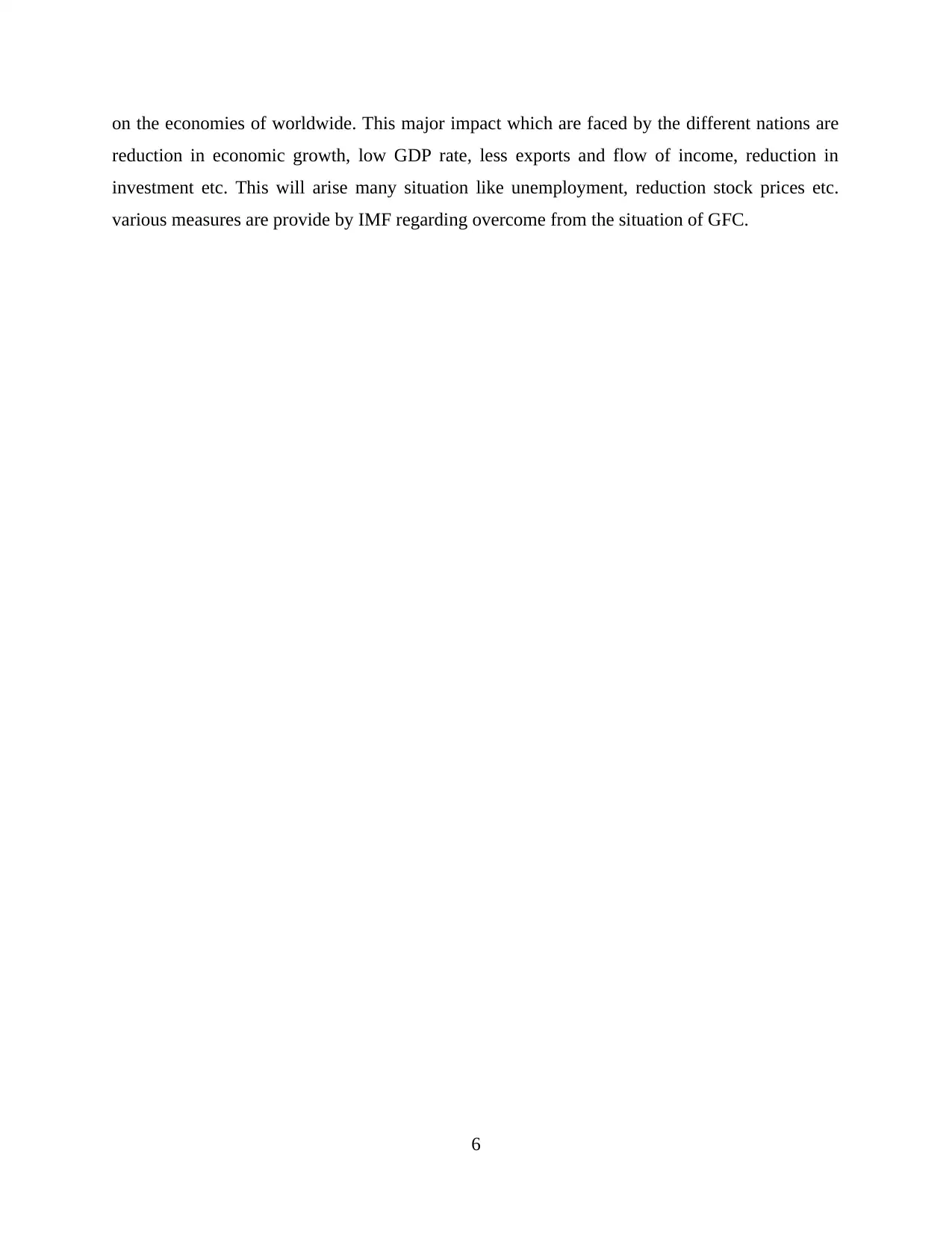
on the economies of worldwide. This major impact which are faced by the different nations are
reduction in economic growth, low GDP rate, less exports and flow of income, reduction in
investment etc. This will arise many situation like unemployment, reduction stock prices etc.
various measures are provide by IMF regarding overcome from the situation of GFC.
6
reduction in economic growth, low GDP rate, less exports and flow of income, reduction in
investment etc. This will arise many situation like unemployment, reduction stock prices etc.
various measures are provide by IMF regarding overcome from the situation of GFC.
6
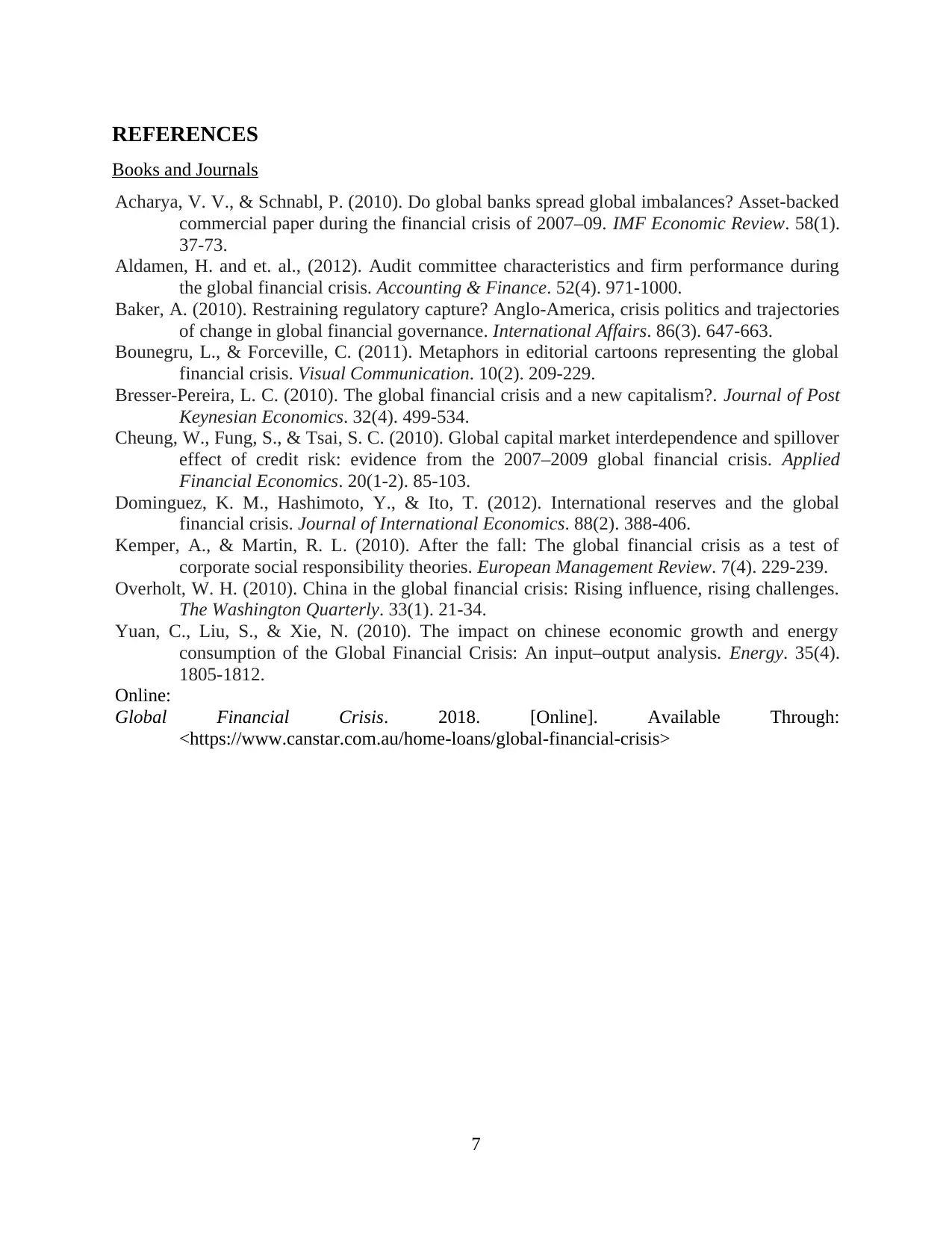
REFERENCES
Books and Journals
Acharya, V. V., & Schnabl, P. (2010). Do global banks spread global imbalances? Asset-backed
commercial paper during the financial crisis of 2007–09. IMF Economic Review. 58(1).
37-73.
Aldamen, H. and et. al., (2012). Audit committee characteristics and firm performance during
the global financial crisis. Accounting & Finance. 52(4). 971-1000.
Baker, A. (2010). Restraining regulatory capture? Anglo-America, crisis politics and trajectories
of change in global financial governance. International Affairs. 86(3). 647-663.
Bounegru, L., & Forceville, C. (2011). Metaphors in editorial cartoons representing the global
financial crisis. Visual Communication. 10(2). 209-229.
Bresser-Pereira, L. C. (2010). The global financial crisis and a new capitalism?. Journal of Post
Keynesian Economics. 32(4). 499-534.
Cheung, W., Fung, S., & Tsai, S. C. (2010). Global capital market interdependence and spillover
effect of credit risk: evidence from the 2007–2009 global financial crisis. Applied
Financial Economics. 20(1-2). 85-103.
Dominguez, K. M., Hashimoto, Y., & Ito, T. (2012). International reserves and the global
financial crisis. Journal of International Economics. 88(2). 388-406.
Kemper, A., & Martin, R. L. (2010). After the fall: The global financial crisis as a test of
corporate social responsibility theories. European Management Review. 7(4). 229-239.
Overholt, W. H. (2010). China in the global financial crisis: Rising influence, rising challenges.
The Washington Quarterly. 33(1). 21-34.
Yuan, C., Liu, S., & Xie, N. (2010). The impact on chinese economic growth and energy
consumption of the Global Financial Crisis: An input–output analysis. Energy. 35(4).
1805-1812.
Online:
Global Financial Crisis. 2018. [Online]. Available Through:
<https://www.canstar.com.au/home-loans/global-financial-crisis>
7
Books and Journals
Acharya, V. V., & Schnabl, P. (2010). Do global banks spread global imbalances? Asset-backed
commercial paper during the financial crisis of 2007–09. IMF Economic Review. 58(1).
37-73.
Aldamen, H. and et. al., (2012). Audit committee characteristics and firm performance during
the global financial crisis. Accounting & Finance. 52(4). 971-1000.
Baker, A. (2010). Restraining regulatory capture? Anglo-America, crisis politics and trajectories
of change in global financial governance. International Affairs. 86(3). 647-663.
Bounegru, L., & Forceville, C. (2011). Metaphors in editorial cartoons representing the global
financial crisis. Visual Communication. 10(2). 209-229.
Bresser-Pereira, L. C. (2010). The global financial crisis and a new capitalism?. Journal of Post
Keynesian Economics. 32(4). 499-534.
Cheung, W., Fung, S., & Tsai, S. C. (2010). Global capital market interdependence and spillover
effect of credit risk: evidence from the 2007–2009 global financial crisis. Applied
Financial Economics. 20(1-2). 85-103.
Dominguez, K. M., Hashimoto, Y., & Ito, T. (2012). International reserves and the global
financial crisis. Journal of International Economics. 88(2). 388-406.
Kemper, A., & Martin, R. L. (2010). After the fall: The global financial crisis as a test of
corporate social responsibility theories. European Management Review. 7(4). 229-239.
Overholt, W. H. (2010). China in the global financial crisis: Rising influence, rising challenges.
The Washington Quarterly. 33(1). 21-34.
Yuan, C., Liu, S., & Xie, N. (2010). The impact on chinese economic growth and energy
consumption of the Global Financial Crisis: An input–output analysis. Energy. 35(4).
1805-1812.
Online:
Global Financial Crisis. 2018. [Online]. Available Through:
<https://www.canstar.com.au/home-loans/global-financial-crisis>
7
1 out of 9
Related Documents
Your All-in-One AI-Powered Toolkit for Academic Success.
+13062052269
info@desklib.com
Available 24*7 on WhatsApp / Email
![[object Object]](/_next/static/media/star-bottom.7253800d.svg)
Unlock your academic potential
© 2024 | Zucol Services PVT LTD | All rights reserved.





